Despite being one of the countries that had the most COVID-19 cases in early 2020, South Korea managed to control the spread of the outbreak in less than a month, and today it has a mortality rate of 0.2% with a cumulative number of positive cases that is flattening out. Added to this, it managed in a short time to stabilize the economy with an aid package equivalent to 31.2% of GDP. The country has a relatively low Public Debt ratio of 40.1% of GDP, below the OECD average, with ample fiscal space to face the crisis and the real GDP forecast for 2020 was revised from -1.2% to -0.8%[1], adding confidence to the measures taken in the face of COVID-19. Simultaneously, South Korea has taken on the task of creating a comprehensive recovery plan called the “Korean New Deal” based on two main components: the “Digital New Deal” and the “Green New Deal”.
But in what consists the successful strategy? What measures had the best effect in controlling the crisis in South Korea? Most importantly, what lessons can we learn to deal with the post-pandemic era and the “new normal”?
These topics were part of the Fourth Regional Dialogue on Fiscal Policy and Management organized by the IDB’s Fiscal Management Division with the Ministry of Economy and Finance of the Republic of Korea under the title “Riding out COVID-19 pandemic: Korea’s economic and fiscal reactions”. Below we detail the 4 main measures that were discussed during the session.
1. Health Response: Creating prevention with the “Three T”: Testing-Tracing-Treating
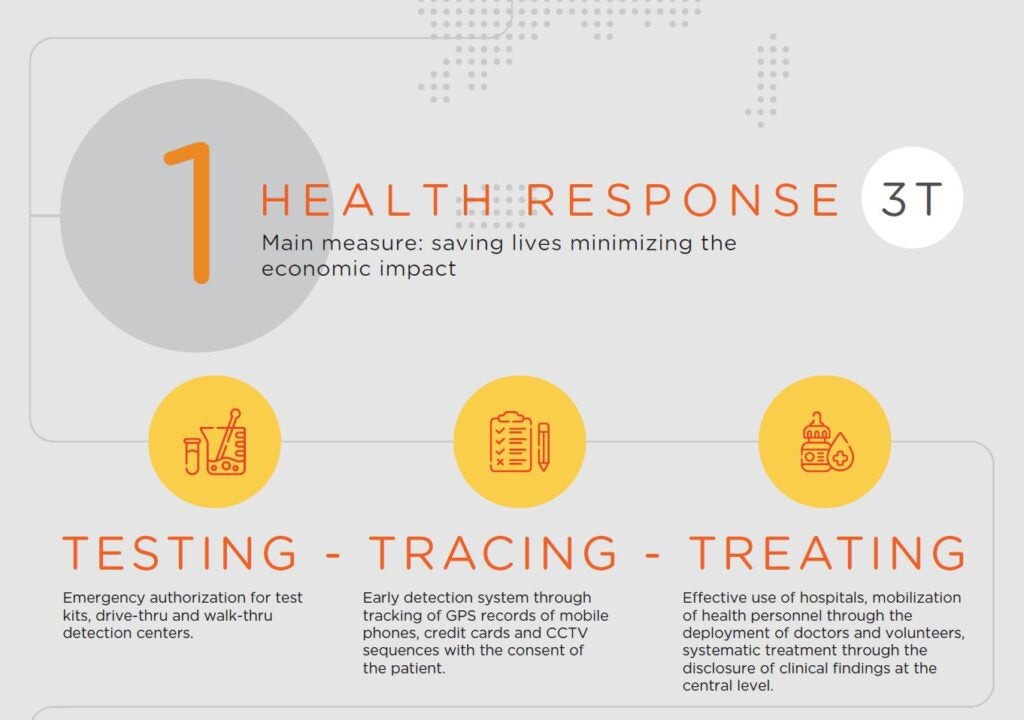
This was the main measure, trying to save lives but minimizing the negative economic impact of the quarantine. It was done by actively maintaining the essential activities to the economy and simultaneously introducing a series of measures under the title of “the three Ts (testing-tracing-treating), which are intensive testing, tracking and treatment measures. In testing, Korea has already carried out 1.5 million tests and has the capacity of more than 15,000 cases per day. Strict social distancing was maintained with the government carefully monitoring for new waves of outbreak. The only difference with other countries is that Korea did not make an absolute blockade of the entry or exit of people from the country, and they gave the population certain freedom to function in daily life. They took effective measures to contain the pandemic at entry and exit points and control primarily at airports. In Seoul, everyone who enters the country has to undergo the coronavirus test; those residing in that capital are offered an exclusive transport to take them to their homes so that they do not have contact in public means of transport. In this way, the 14-day quarantine is carried out, without social contact. An application was also launched for self-health check-ups, a series of fast and extensive tests, and facilities known as “drive thru” and “walk thru” (mobiles tests), minimizing contact with medical personnel. The Korean government also took vigorous measures to investigate the contacts of confirmed patients, using credit card transactions, recordings, and GPS data from cellphones if necessary. Regarding treatments, to hospitalize patients with severe symptoms and provide appropriate treatment options for other confirmed cases, the Korean government classifies patients according to their severity and accommodates them accordingly in hospitals or support centers for treatment.
As a consequence, the Korean government achieved a relatively high quarantine effect without physical containment through the voluntary participation of citizens, along with early detection of confirmed cases through rapid and mass testing, tracing the route of infection using creative methods, handling of meticulous follow-up of confirmed cases and disclosure of information quickly and transparently.
2. Economic response to the crisis: the economic 3T Timely-Targeted-Temporary
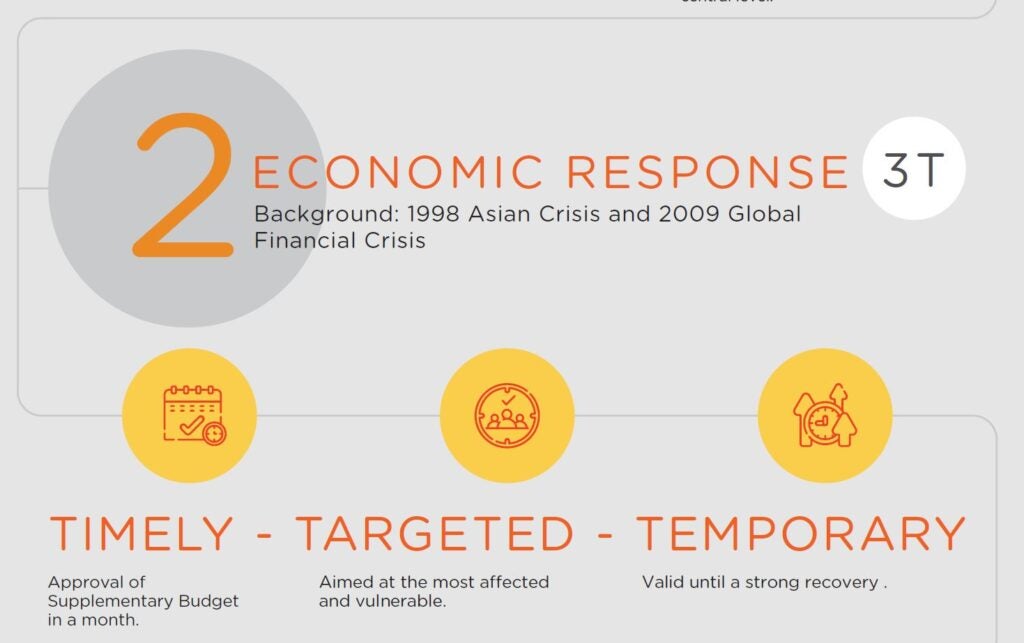
This is not the first time that South Korea has managed a crisis successfully. In fact, in 2009, after the global financial crisis, the country managed to recover in an exemplary manner, considering the context, experience and measures they had taken during the Asian crisis in 1998. In this pandemic, putting into practice what they learned from their own lessons from past crises and taking into account their fiscal space, they established the principles of the “3Ts”. First, a “Timely” and rapid response within one month after having the first case of COVID-19, managing to obtain a supplementary budget to respond to the economic and health crisis. Then, “Targeted” which meant concentrating support prioritizing those individuals in a vulnerable condition to provide them security and employment, and finally, “Temporary”, that is maintaining the measures only until the appearance of a strong recovery.
3. Recovery from the economic crisis or the “3 Ps”: Protection-Promotion-Preparation
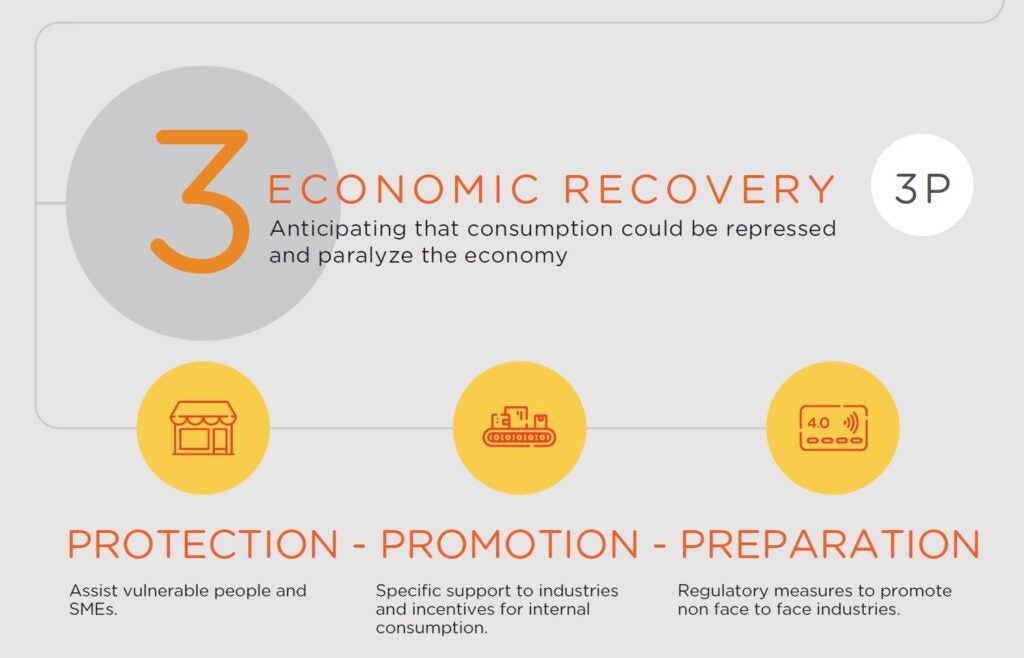
To recover economic activity, the South Korean government took unprecedent measures in the face of the pandemic. They anticipated that the crisis could stifle the incentive to consume and that lack of consumption could paralyze the economy. The set of measures to face the economic shock was based on the “Three Ps”: Protection, Promotion and Preparation. In the first case, the aim was to assist the most vulnerable group of people and small and medium size enterprises (SMEs) by providing salary support, reductions and deferrals in social security contributions, low-rate credits, and special loan guarantees. Regarding “Promotion”, to strengthen economic resilience, specific support was given to industries and incentives for domestic consumption. For the “Preparation”, anticipating the era of post COVID-19, regulatory measures were prepared and the promotion of the 4.0 industry, pointing out the “untact” (the “non face to face”).
4. Preparing to face the post-pandemic or the K-New Deal
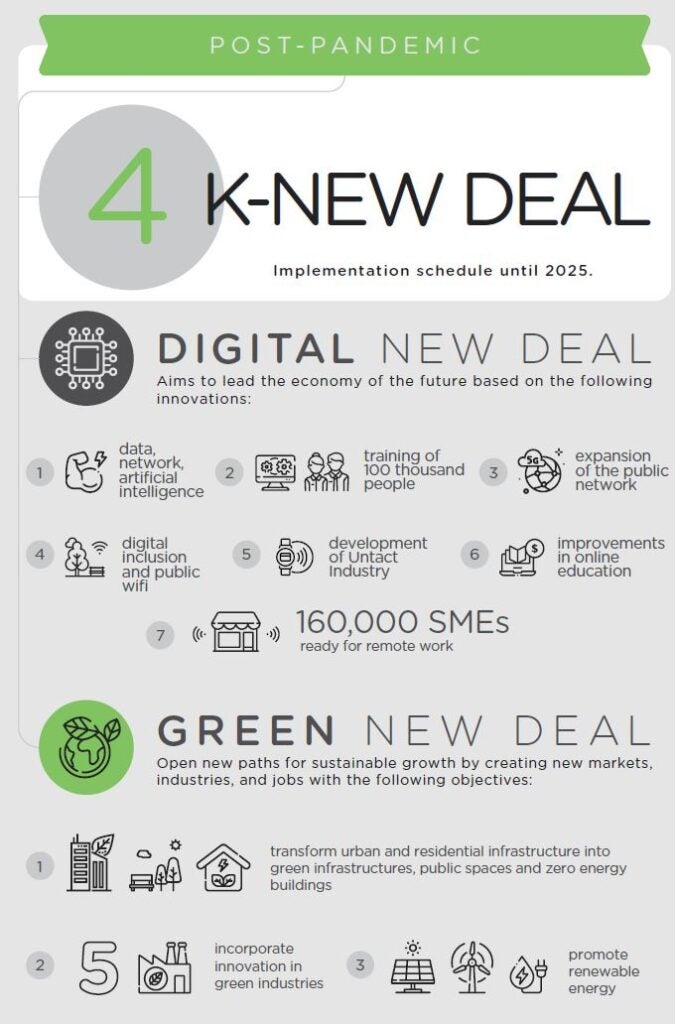
The main objectives of the Korean government for the remainder of the year are to support a rapid recovery of the domestic economy and build an economic base that allows the country to enter the post-COVID-19 era as soon as possible. To achieve this, they are planning the implementation of the Korean version of a New Deal; to promote great innovation in the economic and industrial structure; and manage to become a truly inclusive country.
What is the K-New Deal? It is a strategy divided in two parts, the “Digital New Deal” and the “Green New Deal” with an implementation schedule until 2025. The first of them aims to lead the economy of the future based on innovation, and it will receive an investment of 13.4 trillion won (0.7% of GDP) by 2022 and will create 330 thousand jobs. A part will be invested to strengthen the DNA (in reference to the data, network and Artificial Intelligence sectors); supporting the training of 100 thousand people in software, expansion of the 5G public network and the use, dissemination and construction of data. It will also invest in digital inclusion and for a digital safety net; having “wifi” services in public spaces and to support the development of the “untact” industry. The government will provide digital infrastructure for education at all levels, primary and secondary, while supporting improvements in online education through universities and job training spaces. There will be 160,000 SMEs that will be provided with equipment that allows remote work.
On the other hand, the goal of the “Green New Deal” is to open new paths to sustainable growth. South Korea plans to actively respond to climate change issues, creating new markets, industries, and jobs. The goal is to inject 12.9 trillion won (0.6% of GDP) by 2022 to: a) transform urban and residential infrastructure into green infrastructure; b) public spaces that affect people’s daily lives will be remodeled into “zero energy” buildings; c) to incorporate innovation in the green industry, supporting 5G industries to lead to the fulfillment of this “Green New Deal” and establish green industrial complexes; and d) to support the expansion of the decentralized, low-carbon energy supply. This includes preparing the groundwork to promote the use of renewable energy such as solar, wind and “hydro” energy.
To achieve the vision of a more inclusive country, Korea plans among other measures, both expanding unemployment insurance coverage including even the self-employed, as well as retraining and subsidy programs for elder workers, women, disabled and low income.
How can the Korean experience help to face the challenges that the emergency has brought to Latin America?
There is no doubt that our region is characterized by high informal employment, technological limitations, and fiscal and logistical restrictions to provide social assistance to the most vulnerable population, so there are limitations when it comes to replicating the Korean measures. However, it is important to highlight issues such as transparency, the prevention of duplication of financial support or the delivery of vouchers as social assistance if the beneficiaries lack of bank accounts. By law, people in South Korea are required to declare their domicile, their employment status, and even though they belong to the informal sector, they are required to register with the social safety net.
At the governmental level, one should be prepared to face different unexpected situations. There must be trust from society in the government. In the case of South Korea, in 2015 they had already faced the epidemic of MERS (the Middle East Respiratory Syndrome) learning lessons and having managed to establish governance in emergency situations. Also, on that occasion and currently, control centers were established to be able to obtain information related to the pandemic in a transparent manner and processes were streamlined to produce kits or devices quickly and efficiently.
To the political infrastructure must be added the human, the behavior of society. Voluntarily the small establishments that rented premises in South Korea reduced or exempted the payment of rent in these difficult months. Although no one is obliged, 99 percent of the people wear masks.
On the fiscal side, South Korea aimed to cover as much as possible and efficiently. The fiscal measures announced in developed countries amount to an average of 19% of GDP, including countries such as Italy, Germany, France, and South Korea. In Latin America, the cost of these measures is barely a quarter of the packages announced in developed countries averaging 5% of GDP so far. If loan or loan guarantees are not included, it would be 2.8% of GDP with a great divergence in the region. The blog “Policy and fiscal management during the pandemic and post-pandemic in Latin America and the Caribbean” describes this reaction in detail. Countries that had more debt can spend less. Borrowing is difficult, but multilateral organizations have quickly provided and continue to aid assistance.
How is inclusive growth with fiscal sustainability restored in Latin America after the pandemic?
There are already countries projecting falls up to 15% of GDP, which would have grown without the emergence of the pandemic. The IDB has quickly taken measures to support the countries in the region and the Fiscal Management Division has developed a prototype of projects to support good policies to face the consequences of COVID-19. Ten (10) structured loans have already been approved in two operations: in the first one, all the necessary help is being given to strengthen the emergency budget for health care and the fiscal framework to serve homes and businesses, to operate and receive funds and to improve institutions for a better execution of spending and provision of public services. In a second operation, and with technical cooperation resources, plans and implementation will be designed for economic and fiscal recovery after the emergency. Korea provides enormous lessons for the design of such plans. Encouraging a return to growth with equity will require the implementation of stimulus plans, within the framework of the limited fiscal space available. And it will also be necessary to think about reforms related to improving the efficiency of spending, which cover not only intelligent reallocations of that spending but also a reduction in leakage which in turn is capable to promote sustainable development and digitalization. Without a doubt, the direction and strategy adopted by South Korea can illuminate the way for us.
References
[1] OECD Economic Surveys Korea August 2020

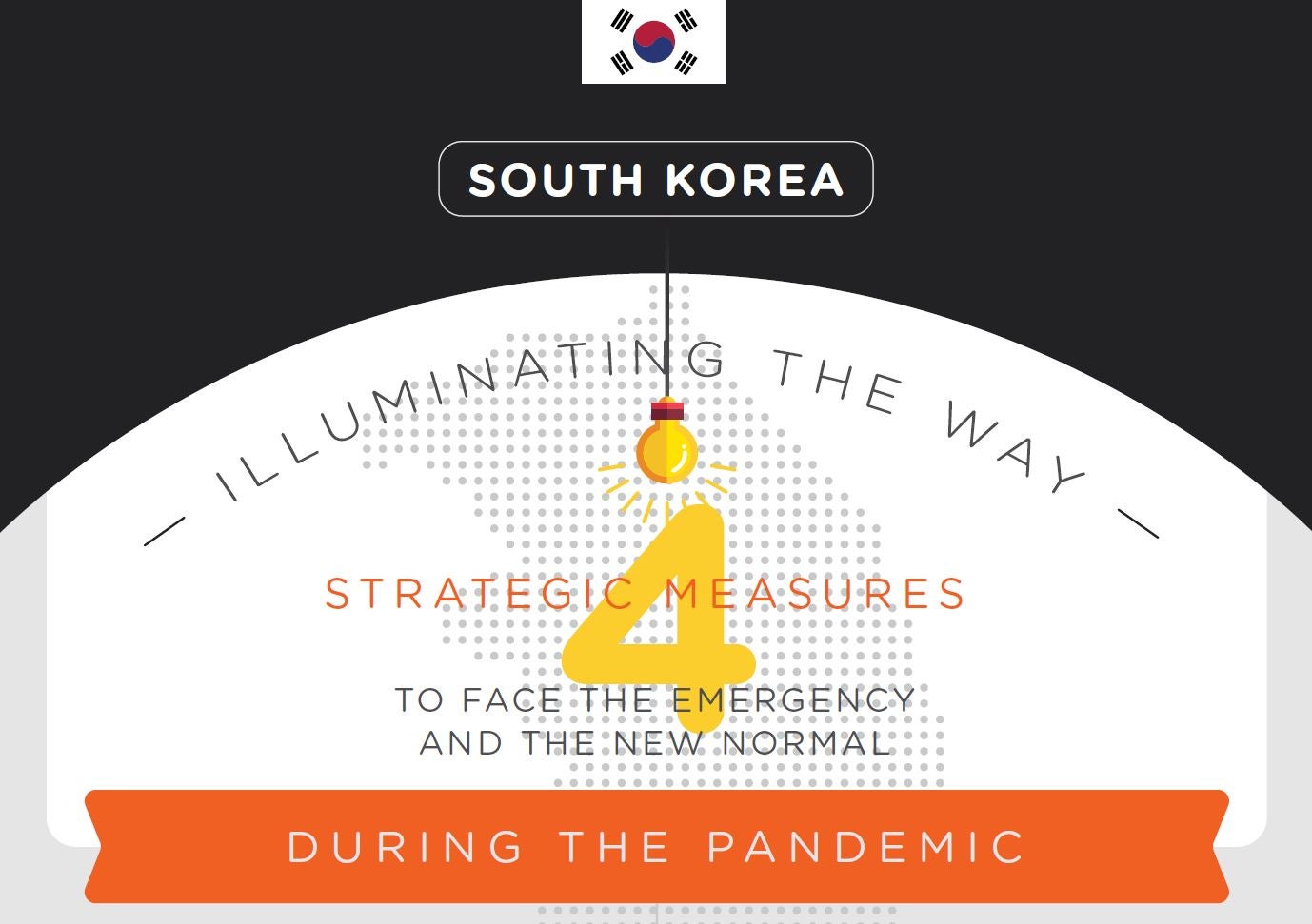
This is a great article outlining a successful response to the COVID-19 pandemic. I would be interested to know if mask utilization was included in any of this, or if it was superfluous (due to the Korean population’s positive attitudes towards mask-wearing).